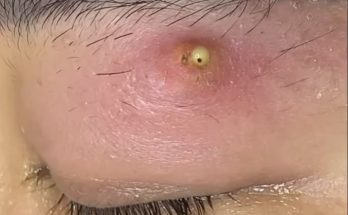“Sticky eye” in babies is a very common condition, often caused by a blocked tear duct (also known as congenital nasolacrimal duct obstruction).1 Tears are produced to keep the eye moist and clean, and they normally drain through tiny openings in the inner corner of the eyelids, through a tear duct, and into the nose.2 If this duct is blocked or underdeveloped, tears can’t drain properly, leading to a build-up of tears, mucus, and stickiness.3
It’s important to differentiate “sticky eye” from conjunctivitis (pink eye), which is an infection. Sticky eye typically involves clear or yellowish-white discharge, sometimes causing eyelashes to stick together, but the white part of the eye usually remains clear (not red or inflamed). If the white of the eye is red, swollen, or there’s a lot of pus-like yellow/green discharge, or your baby has a fever, it’s crucial to consult a doctor as it could be conjunctivitis or a more serious infection requiring medical treatment.
For typical sticky eye due to a blocked tear duct, the good news is that it usually resolves on its own by the time the baby is around 1 year old (in about 90% of cases).4 In the meantime, home care can help manage the symptoms and prevent infection.5
Here’s how to treat a sticky eye in babies:
1. Eyelid Hygiene (Cleaning the Eye)
This is the most important step to keep the eye clean and free from accumulated discharge.
- Wash your hands thoroughly: Before and after cleaning your baby’s eye to prevent the spread of any bacteria.
- Use cooled, boiled water or saline solution: Boil water and let it cool down to a lukewarm temperature. You can also use sterile saline solution (available at pharmacies).6 Do NOT use breast milk if the eye is red or inflamed, as it’s not sterile and could potentially worsen an infection, although some sources suggest it for simple stickiness. Do NOT use chamomile or other herbal infusions.
- Prepare cotton wool balls or gauze: Use clean, sterile cotton wool balls or a soft, clean gauze pad.
- Wipe from inside out: Dip a fresh cotton ball/gauze in the cooled boiled water or saline.7 Gently wipe your baby’s eye from the inner corner (near the nose) outwards towards the ear
- Use a fresh wipe for each swipe: Do not reuse the same cotton ball or pad, even for the same eye.8 This prevents spreading any discharge or potential infection. If both eyes are affected, use separate fresh wipes for each eye.
- Be gentle: Do not rub or apply pressure directly to the eyeball.9
- Repeat as needed: Clean the eye whenever you notice stickiness or discharge, typically several times a day (e.g., after waking up and after baths).
- Pat dry: Gently pat the area around the eye dry with a clean, soft cloth or tissue.10
2. Tear Duct Massage
This technique can help open the blocked tear duct by applying gentle pressure, encouraging the membrane at the end of the duct to open or pushing accumulated fluid through.1
- Wash your hands: Again, good hand hygiene is essential.
- Position your baby: Have your baby lying down comfortably and safely.
- Locate the tear duct area: The tear duct is located in the inner corner of the eye, next to the bridge of the nose.
- Apply gentle pressure: With your clean index finger or the tip of your pinky finger (nail trimmed short), place it on the side of your baby’s nose, where the upper and lower eyelids meet, just below the inner corner of the eye.12
- Massage downwards: Apply gentle, firm pressure and stroke downwards along the side of the nose for about 1-2 cm (about half an inch). The pressure should be moderate, like pressing on a ripe grape, not too hard but enough to create some pressure.
- Repeat: Perform this massage 5-10 times, 2-4 times a day.
- Wipe away discharge: If any discharge or tears come out during the massage, gently wipe them away as per the cleaning instructions above.
Important Considerations:
- Patience: Blocked tear ducts often take time to resolve.13 Continue with cleaning and massage consistently.
When to see a doctor immediately (urgent care):
- Redness or swelling of the white part of the eye (sclera) or around the eye.
- Thick, green, or yellow pus-like discharge that is persistent or worsening.
- The baby seems in pain, is irritable, or rubbing their eye excessively.14
- Eyelids are swollen and tender.
- Fever or the baby seems generally unwell.
- Baby is less than 1 month old and has any eye discharge or redness.
- Sensitivity to light (photophobia).
- Difficulty opening the eye due to swelling or pain.15
- These signs could indicate an eye infection (conjunctivitis), dacryocystitis (infection of the tear sac), or a more serious condition requiring prompt medical attention and potentially antibiotics
- When to see a doctor non-urgently:
- If the sticky eye persists beyond 12 months of age, your doctor might refer you to an eye specialist (ophthalmologist) for further evaluation. They may consider a procedure called tear duct probing to open the duct, which is usually very successful.16
Always consult your pediatrician or a healthcare professional if you are concerned about your baby’s sticky eye or if the symptoms worsen or change.

